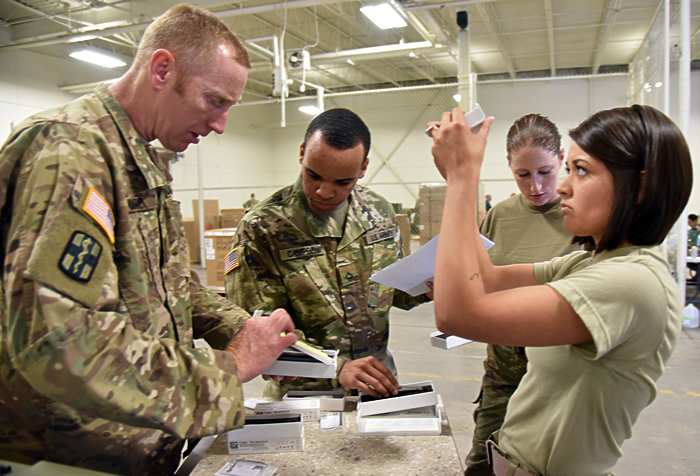Army Combat Support Hospitals Converting to New Modular Field Hospitals

The 10th Combat Support Hospital (CSH) became the Army's first unit to convert to the new Field Hospital (FH) design June 16, after completing materiel fielding with the U.S. Army Medical Materiel Agency.
The conversion reconfigures the 248-bed CSH into a smaller, more modular 32-bed FH with three additional augmentation detachments including a 24-bed surgical detachment, a 32-bed medical detachment, and a 60-bed Intermediate Care Ward detachment. The FH and the augmentation detachments will all operate under the authority of a headquarters hospital center.
"We have Soldiers supporting missions all over the world. Our ability to organize tailorable medical support packages with ease and agility is critical to supporting our men and women in a multi-domain battlefield. This conversion allows Commanders flexibility to respond with a capability that is sized according to the requirement," said Maj. Gen. Brian C. Lein, commanding general of the U.S. Army Medical Department Center and School, Health Readiness Center of Excellence.
The FH design is based on lessons learned from more than a decade of combat that have reinforced the Army's need to have forward-based medical capabilities that are advanced yet also agile and logistically scalable. Traditional CSHs have proven to be too large and logistically difficult to deploy as a whole, which is why the Army has historically only deployed "slices" or sections of the CSH. The move to the FH design codifies that practice by restructuring the CSH in the way it is primarily used – as a customizable, scalable resource.

"This new structure and the way it is organized with the main capability in the 32-bed hospital and the three augmentation detachments that fill out the capability and the capacity is really neat. I think it will be great for split-based operations. It's tailorable and scalable, and it's also responsive to a different range of military operations and not just a campaign war fight," said Col. Mark Stevens, who commands the headquarters hospital center over the new 10th FH and augmentation detachments.
During the FH conversion, which took place at Fort Carson, Colorado, USAMMA and the unit laterally transferred about 1,500 pieces of existing equipment to reuse supplies and materiel to minimize costs. Additionally, USAMMA fielded approximately $9 million in modernized medical equipment and supplies, according to Rufus Pruitt, USAMMA's Western/Pacific Regional manager of the Force Sustainment Directorate. In addition to USAMMA's medical materiel fielding team, which included the USAMMA's regional Medical Liaison Officer Mike Mc Hale, nearly 100 local Soldiers and five company command teams participated in the fielding operation.
"It is an understatement to say it is a learning experience. This is a definite learning experience not only for myself but also for all of my Soldiers who have just come into the military and have never served with an operational unit before," said Capt. Kathryn Willison, who now leads the 10th FH Headquarters Company. "The true workhorses and the true heroes of this whole conversion have been my Soldiers. They've worked tirelessly to prep for inventory, to do the inventories, to pack and repack –and pack and repack— and they have been absolutely outstanding. I know this conversion would not have been as smooth without the dedication and focus of my Soldiers."

Sgt. Patrick Maloon, a Soldier who took part in the FH conversion fielding said, "I am excited about the new field hospital design because it is keeping us relevant and making us more expeditionary, so we can go where the Soldier goes and provide care where needed, as far forward as possible."
The new 10th FH and augmentation detachments plan to test the FH design up to three times at various exercises through the next year. According to Stevens, these exercises will provide critical training for the troops and help them identify "friction points."
"In Army Medicine, we have to keep up with the changing environment," said Lt. Col. Sabrina Thweatt, who serves as the 10th FH commander. "When we are on the battlefield, people want to know that the medical capability is there, should something happen. And we need to be able to get to them easier and faster – and hopefully the field hospital concept will do that."
Over the next five years, the Army plans to convert the rest of the active duty CSHs, as well as Army Reserve hospitals that are part of the Medical Materiel Readiness Program and Army Prepositioned Sustainment stocks hospitals, into the new FH design. The next CSH slated for conversion is the 31st CSH based out of Fort Bliss located in El Paso, Texas.
USAMMA is a subordinate agency of the U.S. Army Medical Research and Materiel Command, which is the Army's main medical materiel developer. USAMMA's mission is to develop, tailor, deliver, and sustain medical materiel capabilities and data in order to build and enable health readiness.














